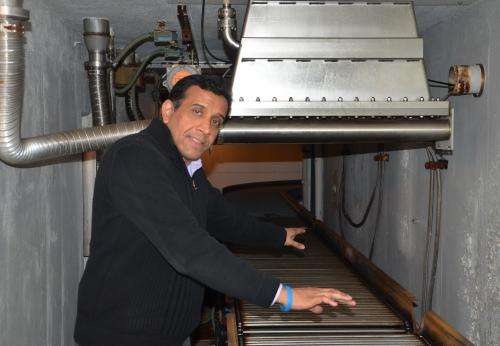Electron-beam technology a better way to sanitize Ebola waste?

Dr. Suresh D. Pillai doesn't want to sensationalize the use of electron beam technology by solely talking about using it to sanitize ebola virus contaminated equipment and wastewater.
However, he said, it could be much safer and more cost effective than methods used now.
Pillai is a Texas A&M AgriLife Research scientist and director of the National Center for Electron Beam Research at College Station. The center's main instrumentation, a 10-million electron volt, 18-kilowatt, electron beam, or eBeam, has primarily been used for research in food safety, food quality, environmental protection and aerospace applications, according to Pillai.
But the technology is capable of being adapted to many other applications, such as the sterilization of wastewater and hospital waste, he said. Moreover, eBeam units have the potential of doing these kinds of jobs more effectively and at a lower cost than conventional means.
For some time, hospitals have used similar technology, though at lower power levels, to sterilize equipment. But contagious hospital waste, such as disposable equipment, is typically treated with pressurized steam or incinerated, while wastewater from quarantine units is usually chemically disinfected and then disposed of normally, Pillai said.
Though Pillai, who is trained as a microbiologist, doesn't question the effectiveness of these means in terms of sanitization, eBeam technology could not only be potentially more cost effective, it would certainly be "greener" environmentally.
"One of the beautiful aspects of electron-beam technology is that it uses commercial electricity to generate the electrons," he said. "There is no need for radioactive isotopes or chemicals."
Pillai said eBeam units can be in some ways compared to microwave ovens used in homes. Both microwaves and e-beams begin with electrically generated electrons. Both can be switched on immediately when needed and switched off when the job is done, whether it be cooking or sterilization. And neither leave any chemical or radioactive residue behind
Of course, he said, commercial eBeams are many times more powerful than microwave ovens. Electron beams used for sterilization typically have energy levels of 3 million to 10 million electron volts.
Electron beam technology is a proven technology, having been adopted for commercial use decades ago, he said. For example, one of the most common uses of electron-beam commercial units is the disinfection of spices. The treatment kills bacteria but does not affect the color, flavor or taste of the spice, as practically any other treatment would.
"Electron-beam technology is also very 'scalable,' he said. "This is a technology that is already available off–the-shelf for many applications. It is adaptable to municipalities and cities and even hospitals for wastewater treatment and other applications."
One problem is, Pillai said, that until the technology is more widely adopted, the initial costs can be quite steep. And though it is not a one-size-fits-all technology, there are plans and studies in place for all sorts of applications. For example, in the case of a hospital faced with handling a new, possible one-time threat, there are designs in place for mobile units that could be transported to the site to sterilize disposal equipment and treating wastewater streams.
"They wouldn't be really small but relatively miniaturized, in the sense they could be transportable on one, maybe two trailer trucks."
The technology can also be scaled up, perhaps for a large city's wastewater treatment plant, Pillai said.
"There's obviously going to be a need for larger size installations for cities the size of Houston or Dallas," he said. Pillai says that the cost per gallon of treating contaminated materials or wastewater would decrease with increasing volumes.
The center is currently conducting a state of Texas funded research project to evaluate eBeam technology for water reuse projects. Using eBeam technology can result in elimination of chemical disinfectants and reduce the treatment costs, Pillai said.
"We have actually shown and published how electron beam sanitization can make the whole process a lot more cost-effective, a lot less expensive, than current technology," he said. "We're reaching out to work with the Texas Water Development Board and the Texas Commission on Environmental Quality to get more people to familiarize themselves with this technology."
Electron beam technology has been demonstrated in Europe to clean industrial emissions from power-plant smokestacks, according to Pillai.
"Unfortunately, there are lots of naysayers who talk about negative aspects of this technology without actually understanding it," he said. "One of the goals of the center is to educate decision-makers and the general public about the benefits of this technology. It is extremely important for an advanced country like the United States to adopt this technology to solve some of the contemporary challenges we face, such as infectious waste."



















